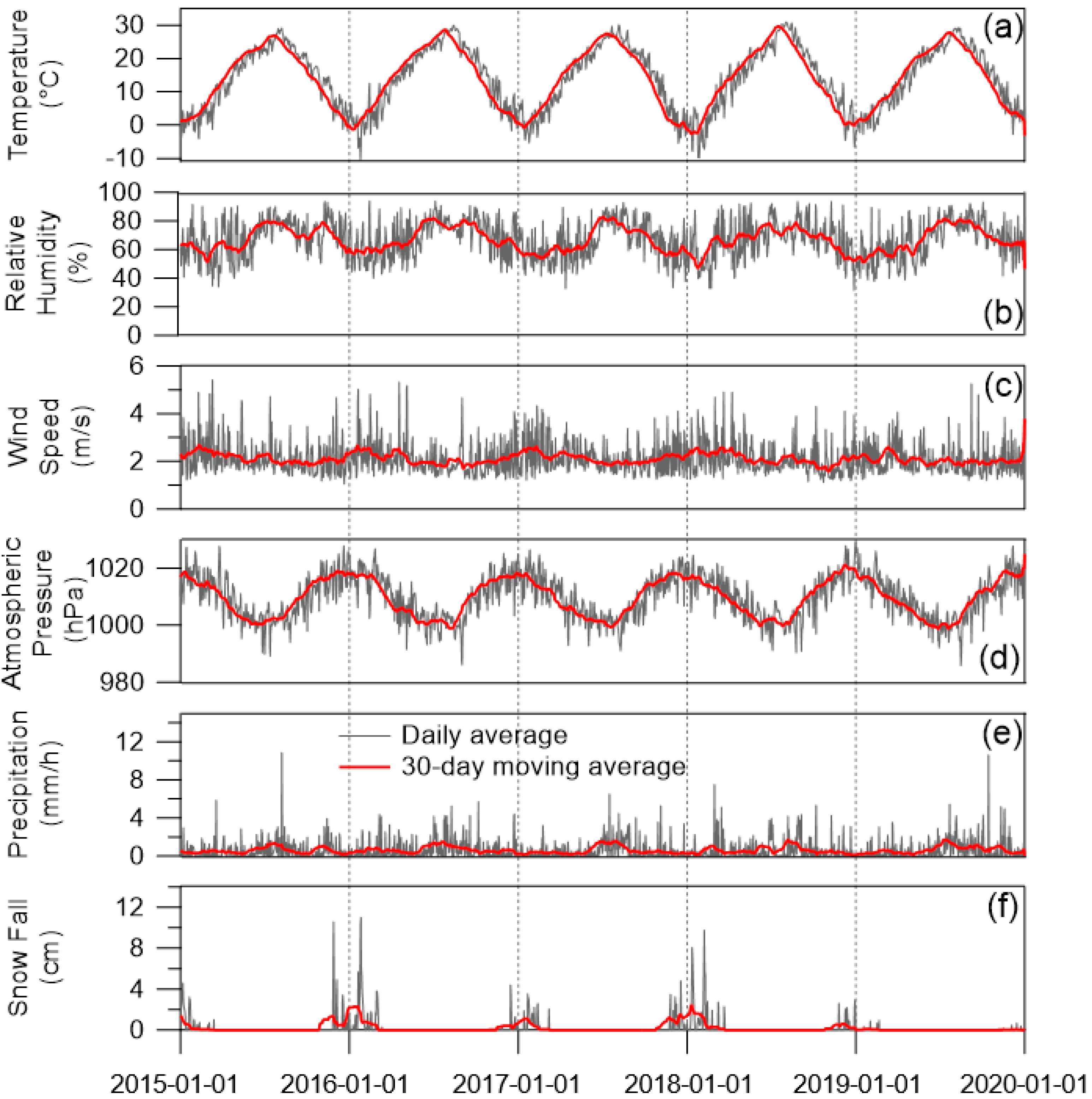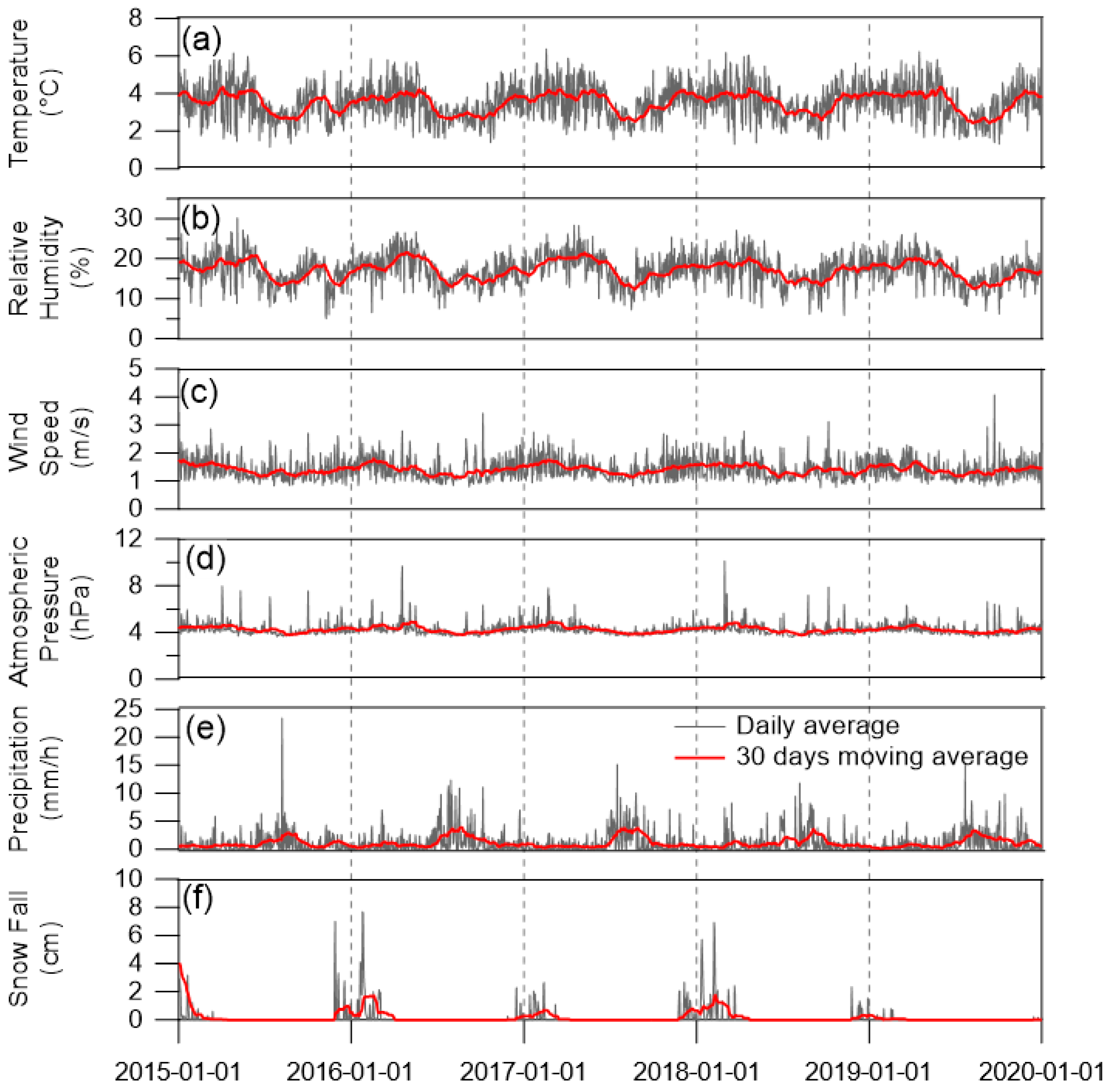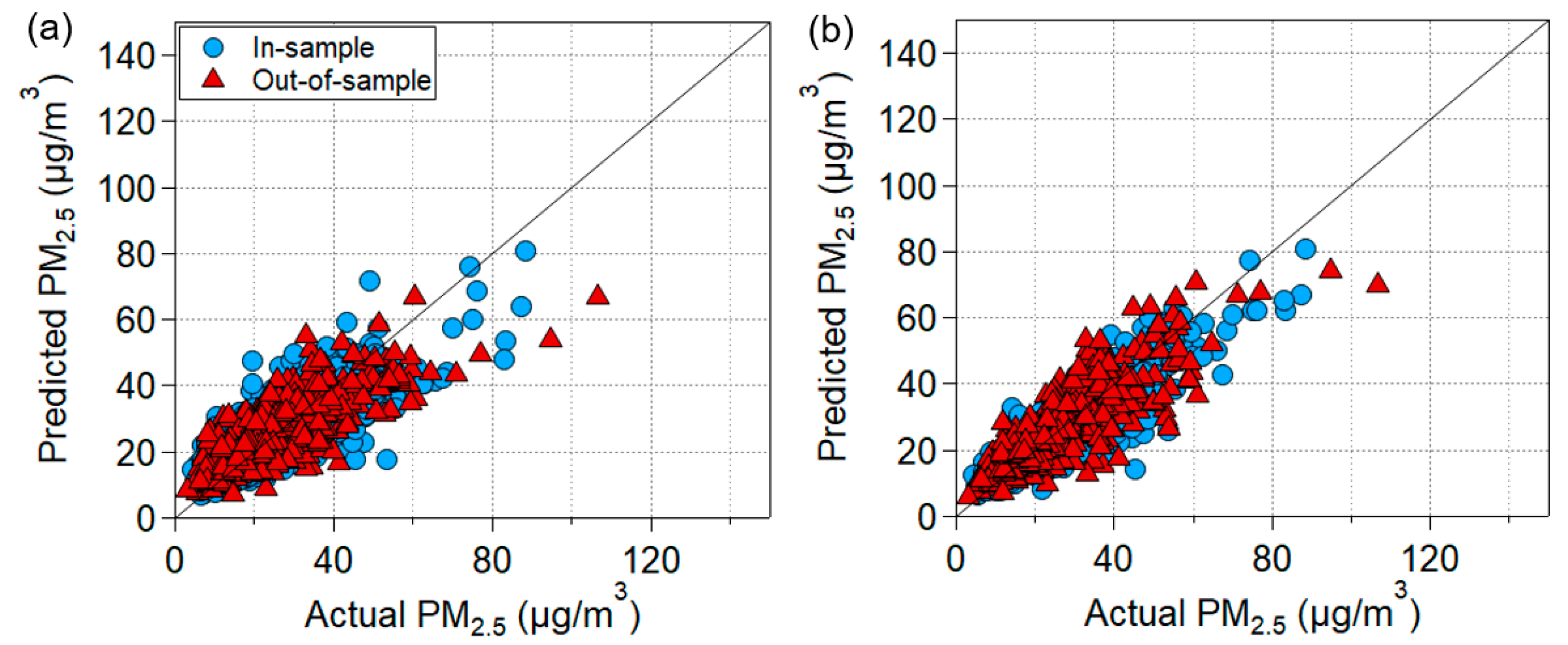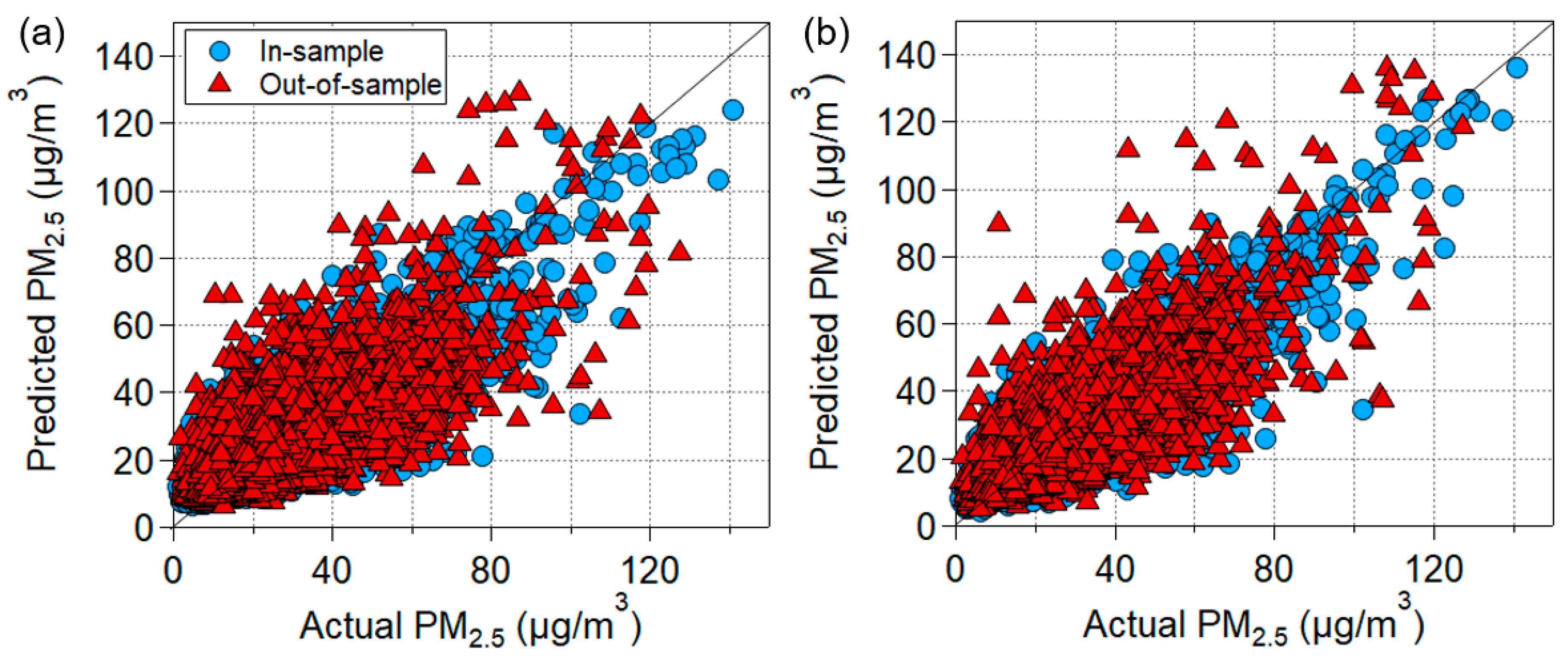Development of a Prediction Model for Daily PM2.5 in Republic of Korea by Using an Artificial Neutral Network
Abstract
1. Introduction
2. Materials and Methods
2.1. Air Pollutants and Meteorological Data
2.2. Artificial Neural Networks
2.3. Model Validation Metrics
3. Results and Discussion
3.1. Trend and Correlation Analysis for Input Parameter
3.2. PM2.5 Prediction Model for Nationwide
3.3. PM2.5 Prediction Model for Administrative Districts
4. Conclusions
Supplementary Materials
Author Contributions
Funding
Institutional Review Board Statement
Informed Consent Statement
Data Availability Statement
Acknowledgments
Conflicts of Interest
References
- Kim, K.H.; Kabir, E.; Kabir, S. A review on the human health impact of airborne particulate matter. Environ. Int. 2015, 74, 136–143. [Google Scholar] [CrossRef]
- Wang, Z.; Itahashi, S.; Uno, I.; Pan, X.; Osada, K.; Yamamoto, S.; Nishizawa, T.; Tamura, K.; Wang, Z. Modeling the long-range transport of particulate matters for january in East Asia using NAQPMS and CMAQ. Aerosol Air Qual. Res. 2017, 17, 3065–3078. [Google Scholar] [CrossRef]
- Lee, P.H.; Park, S.; Lee, Y.G.; Choi, S.M.; An, M.H.; Jang, A.S. The impact of environmental pollutants on barrier dysfunction in respiratory disease. Allergy Asthma Immunol. Res. 2021, 13, 850. [Google Scholar] [CrossRef]
- Rosman, P.S.; Samah, M.A.A.; Yunus, K.; Hussain, M.R.M. Particulate matter (PM 2.5) at construction site: A review. Int. J. Recent Technol. Eng. 2019, 8, 255–259. [Google Scholar]
- Hamanaka, R.B.; Mutlu, G.M. Particulate Matter Air Pollution: Effects on the Cardiovascular System. Front. Endocrinol. 2018, 9, 68. [Google Scholar] [CrossRef]
- WHO. WHO|Air Pollution; World Health Organization: Geneva, Switzerland, 2019. [Google Scholar]
- Zwozdziak, A.; Sówka, I.; Willak-Janc, E.; Zwozdziak, J.; Kwiecińska, K.; Balińska-Miśkiewicz, W. Influence of PM1 and PM2.5 on lung function parameters in healthy schoolchildren—A panel study. Environ. Sci. Pollut. Res. 2016, 23, 23892–23901. [Google Scholar] [CrossRef]
- Yang, M.; Guo, Y.M.; Bloom, M.S.; Dharmagee, S.C.; Morawska, L.; Heinrich, J.; Jalaludin, B.; Markevychd, I.; Knibbsf, L.D.; Lin, S.; et al. Is PM1 similar to PM2.5? A new insight into the association of PM1 and PM2.5 with children’s lung function. Environ. Int. 2020, 145, 106092. [Google Scholar] [CrossRef]
- Bonyadi, Z.; Ehrampoush, M.H.; Ghaneian, M.T.; Mokhtari, M.; Sadeghi, A. Cardiovascular, respiratory, and total mortality attributed to PM2.5 in Mashhad, Iran. Environ. Monit. Assess. 2016, 188, 570. [Google Scholar] [CrossRef]
- Sherris, A.R.; Begum, B.A.; Baiocchi, M.; Goswami, D.; Hopke, P.K.; Brooks, W.A.; Luby, S.P. Associations between ambient fine particulate matter and child respiratory infection: The role of particulate matter source composition in Dhaka, Bangladesh. Environ. Pollut. 2021, 290, 118073. [Google Scholar] [CrossRef]
- Paterson, C.A.; Sharpe, R.A.; Taylor, T.; Morrissey, K. Indoor PM2.5, VOCs and asthma outcomes: A systematic review in adults and their home environments. Environ. Res. 2021, 202, 111631. [Google Scholar] [CrossRef]
- Vu, B.N.; Tapia, V.; Ebelt, S.; Gonzales, G.F.; Liu, Y.; Steenland, K. The association between asthma emergency department visits and satellite-derived PM2.5 in Lima, Peru. Environ. Res. 2021, 199, 111226. [Google Scholar] [CrossRef]
- Sharma, S.K.; Mandal, T.K.; Sharma, A.; Jain, S. Saraswati Carbonaceous Species of PM2.5 in Megacity Delhi, India During 2012–2016. Bull. Environ. Contam. Toxicol. 2018, 100, 695–701. [Google Scholar] [CrossRef]
- Khan, Z.Y.; Kettler, J.; Khwaja, H.A.; Naqvi, I.I.; Malik, A.; Stone, E.A. Organic aerosol characterization and source identification in Karachi, Pakistan. Aerosol Air Qual. Res. 2018, 18, 2550–2564. [Google Scholar] [CrossRef]
- IARC. IARC Monographs on the Evaluation of Carcinogenic Risks to Humans: Outdoor Air Pollution; IARC: Lyon, France, 2015; Volume 109, ISBN 9789283201755. [Google Scholar]
- WHO. WHO Global Air Quality Guidelines; Coastal and Estuarine Process; WHO: Geneva, Switzerland, 2021; pp. 1–360. [Google Scholar]
- Kim, I.; Lee, K.; Lee, S.; Kim, S.D. Characteristics and health effects of PM2.5 emissions from various sources in Gwangju, South Korea. Sci. Total Environ. 2019, 696, 133890. [Google Scholar] [CrossRef]
- Park, E.H.; Heo, J.; Kim, H.; Yi, S.M. Long term trends of chemical constituents and source contributions of PM2.5 in Seoul. Chemosphere 2020, 251, 126371. [Google Scholar] [CrossRef]
- Schlosser, J.S.; Stahl, C.; Sorooshian, A.; Le, Y.T.H.; Jeon, K.J.; Xian, P.; Jordan, C.E.; Travis, K.R.; Crawford, J.H.; Gong, S.Y.; et al. Evidence of haze-driven secondary production of supermicrometer aerosol nitrate and sulfate in size distribution data in South Korea. Atmos. Chem. Phys. 2022, 22, 7505–7522. [Google Scholar] [CrossRef]
- Kumar, N.; Park, R.J.; Jeong, J.I.; Woo, J.H.; Kim, Y.; Johnson, J.; Yarwood, G.; Kang, S.; Chun, S.; Knipping, E. Contributions of international sources to PM2.5 in South Korea. Atmos. Environ. 2021, 261, 118542. [Google Scholar] [CrossRef]
- Jeon, W.; Choi, Y.; Percell, P.; Hossein Souri, A.; Song, C.K.; Kim, S.T.; Kim, J. Computationally efficient air quality forecasting tool: Implementation of STOPS v1.5 model into CMAQ v5.0.2 for a prediction of Asian dust. Geosci. Model Dev. 2016, 9, 3671–3684. [Google Scholar] [CrossRef]
- Ho, C.H.; Park, I.; Kim, J.; Lee, J.B. PM2.5 Forecast in Korea using the Long Short-Term Memory (LSTM) Model. Asia-Pacific J. Atmos. Sci. 2022, 2022, 1–14. [Google Scholar] [CrossRef]
- Appel, K.W.; Napelenok, S.L.; Foley, K.M.; Pye, H.O.T.; Hogrefe, C.; Luecken, D.J.; Bash, J.O.; Roselle, S.J.; Pleim, J.E.; Foroutan, H.; et al. Description and evaluation of the Community Multiscale Air Quality (CMAQ) modeling system version 5.1. Geosci. Model Dev. 2017, 10, 1703–1732. [Google Scholar] [CrossRef]
- Chang-Hoi, H.; Park, I.; Oh, H.R.; Gim, H.J.; Hur, S.K.; Kim, J.; Choi, D.R. Development of a PM2.5 prediction model using a recurrent neural network algorithm for the Seoul metropolitan area, Republic of Korea. Atmos. Environ. 2021, 245, 118021. [Google Scholar] [CrossRef]
- Cheng, Y.; Zhang, H.; Liu, Z.; Chen, L.; Wang, P. Hybrid algorithm for short-term forecasting of PM2.5 in China. Atmos. Environ. 2019, 200, 264–279. [Google Scholar] [CrossRef]
- Wang, X.; Yuan, J.; Wang, B. Prediction and analysis of PM2.5 in Fuling District of Chongqing by artificial neural network. Neural Comput. Appl. 2021, 33, 517–524. [Google Scholar] [CrossRef]
- Ghosal, P.S.; Gupta, A.K. Enhanced efficiency of ANN using non-linear regression for modeling adsorptive removal of fluoride by calcined Ca-Al-(NO3)-LDH. J. Mol. Liq. 2016, 222, 564–570. [Google Scholar] [CrossRef]
- Polezer, G.; Tadano, Y.S.; Siqueira, H.V.; Godoi, A.F.L.; Yamamoto, C.I.; de André, P.A.; Pauliquevis, T.; Andrade, M.d.F.; Oliveira, A.; Saldiva, P.H.N.; et al. Assessing the impact of PM2.5 on respiratory disease using artificial neural networks. Environ. Pollut. 2018, 235, 394–403. [Google Scholar] [CrossRef]
- Dutta, A.; Jinsart, W. Air Pollution in Indian Cities and Comparison of MLR, ANN and CART Models for Predicting PM10 Concentrations in Guwahati, India. Asian J. Atmos. Environ. 2021, 15, 68–93. [Google Scholar] [CrossRef]
- Taylan, O.; Alkabaa, A.S.; Alamoudi, M.; Basahel, A.; Balubaid, M.; Andejany, M.; Alidrisi, H. Air quality modeling for sustainable clean environment using anfis and machine learning approaches. Atmosphere 2021, 12, 713. [Google Scholar] [CrossRef]
- Zou, B.; Wang, M.; Wan, N.; Wilson, J.G.; Fang, X.; Tang, Y. Spatial modeling of PM2.5 concentrations with a multifactoral radial basis function neural network. Environ. Sci. Pollut. Res. 2015, 22, 10395–10404. [Google Scholar] [CrossRef]
- Fang, M.; Zhu, G.; Zheng, X.; Yin, Z. Study on air fine particles pollution prediction of main traffic route using artificial neural network. In Proceedings of the International Conference on Computer Distributed Control and Intelligent Environmental Monitoring, CDCIEM 2011, Changsha, China, 19–20 February 2011. [Google Scholar]
- Lu, H.; Xie, M.; Wu, Z.; Liu, B.; Gao, Y.; Chen, G.; Li, Z. Adjusting PM2.5 prediction of the numerical air quality forecast model based on machine learning methods in Chengyu region. Huanjing Kexue Xuebao/Acta Sci. Circumstantiae 2020, 40, 4419–4431. [Google Scholar] [CrossRef]
- McKendry, I.G. Evaluation of artificial neural networks for fine particulate pollution (PM10 and PM2.5) forecasting. J. Air Waste Manag. Assoc. 2002, 52, 1096–1101. [Google Scholar] [CrossRef]
- Sun, W.; Sun, J. Daily PM2.5 concentration prediction based on principal component analysis and LSSVM optimized by cuckoo search algorithm. J. Environ. Manag. 2017, 188, 144–152. [Google Scholar] [CrossRef] [PubMed]
- Hoffman, S.; Jasiński, R. The Use of Multilayer Perceptrons to Model PM2.5 Concentrations at Air Monitoring Stations in Poland. Atmosphere 2023, 14, 96. [Google Scholar] [CrossRef]
- Youn, J.S.; Seo, J.W.; Park, W.; Park, S.; Jeon, K.J. Prediction model for dry eye syndrome incidence rate using air pollutants and meteorological factors in south korea: Analysis of sub-region deviations. Int. J. Environ. Res. Public Health 2020, 17, 4969. [Google Scholar] [CrossRef]
- Air Korea (Operated by Korea Environment Corporation). Available online: https://www.airkorea.or.kr (accessed on 21 January 2023).
- Open MET Data Poratal (Operated by Korea Meteorological Administration). Available online: https://data.kma.go.kr/ (accessed on 21 January 2023).
- Adeyemo, A.; Wimmer, H.; Powell, L.M. Effects of Normalization Techniques on Logistic Regression in Data Science. J. Inf. Syst. Appl. Res. 2020, 12, 89–104. [Google Scholar]
- Riedmiller, M.; Braun, H. RPROP—A Fast adaptive learning algorithm. In Proceedings of the Seventh International Symposium on Computer and Information Sciences, Santa Cruz, CA, USA, 22–25 June 1992. [Google Scholar]
- Günther, F.; Fritsch, S. Neuralnet: Training of neural networks. R J. 2010, 2, 30–38. [Google Scholar] [CrossRef]
- Papalambros, P.Y.; Wilde, D.J. Forecasting: Principles and Practice; OTexts: Melbourn, Australia, 2018. [Google Scholar]
- Stathakis, D. How many hidden layers and nodes? Int. J. Remote Sens. 2009, 30, 2133–2147. [Google Scholar] [CrossRef]
- Thomas, A.J.; Petridis, M.; Walters, S.D.; Gheytassi, S.M.; Morgan, R.E. Two hidden layers are usually better than one. In Proceedings of the Communications in Computer and Information Science, Athens, Greece, 25–27 August 2017. [Google Scholar]
- Wanas, N.; Auda, G.; Kamel, M.S.; Karray, F. On the optimal number of hidden nodes in a neural network. In Proceedings of the Canadian Conference on Electrical and Computer Engineering, Waterloo, ON, Canada, 25–28 May 1998. [Google Scholar]
- Shmueli, G.; Bruce, P.C.; Gedeck, P.; Patel, N.R. Data Mining for Business Analytics. Concepts, Techniques and Applications in Python; Wiley: Hoboken, NJ, USA, 2020; ISBN 9781119549840. [Google Scholar]









| Factors | Categories | Variables |
|---|---|---|
| Air Pollutant Factors (Daily Average) | PM10, NO2, SO2, O3, CO, PM2.5 | x1, x2, x3, x4, x5, x6 |
| Air Pollutant Factors (Daily Variance) | PM10, NO2, SO2, O3, CO, PM2.5 | xv1, xv2, xv3, xv4, xv5, xv6 |
| Meteorological Factors (Daily Average) | Temperature, Humidity, Wind Speed, Atmospheric Pressure, Precipitation, Snowfall | z1, z2, z3, z4, z5, z6 |
| Meteorological Factors (Daily Variance) | Temperature, Humidity, Wind Speed, Atmospheric Pressure, Precipitation, Snowfall | zv1, zv2, zv3, zv4, zv5, zv6 |
| Next-day PM2.5 (Daily Average) | PM2.5 | y |
| Factor Name | Month | Hidden Layer Layout | Threshold |
|---|---|---|---|
| Factor Level | Included Not Included | 6 × 6 12 × 12 24 × 24 | 0.01 0.05 0.1 |
| 1 σ | 0.5 σ | 0.25 σ | |
|---|---|---|---|
| Value | 12 | 6 | 3 |
| Factor | Average | Median | Min | Max | Standard Deviation | |||||
|---|---|---|---|---|---|---|---|---|---|---|
| NW | AD | NW | AD | NW | AD | NW | AD | NW | AD | |
| PM10(μg/m3) | 44.49 | 43.34 | 41.24 | 39.11 | 7.79 | 5.19 | 377.21 | 555.69 | 21.77 | 22.848 |
| NO2 (ppm) | 0.022 | 0.020 | 0.021 | 0.018 | 0.006 | 0.003 | 0.055 | 0.082 | 0.008 | 0.010 |
| SO2 (ppm) | 0.004 | 0.004 | 0.004 | 0.004 | 0.003 | 0.001 | 0.011 | 0.025 | 0.001 | 0.002 |
| O3 (ppm) | 0.028 | 0.029 | 0.027 | 0.028 | 0.006 | 0.001 | 0.074 | 0.092 | 0.011 | 0.012 |
| CO (ppm) | 0.490 | 0.477 | 0.457 | 0.446 | 0.277 | 0.113 | 1.058 | 1.485 | 0.129 | 0.151 |
| PM2.5 (μg/m3) | 24.634 | 24.633 | 22.573 | 21.917 | 3.393 | 1.045 | 106.897 | 140.793 | 12.243 | 13.898 |
| Factor | Mean | Median | Min | Max | Standard Deviation | |||||
|---|---|---|---|---|---|---|---|---|---|---|
| NW | AD | NW | AD | NW | AD | NW | AD | NW | AD | |
| T (°C) | 13.96 | 14.21 | 14.77 | 15.28 | −10.47 | −14.74 | 30.96 | 33.74 | 9.51 | 9.61 |
| RH (%) | 66.99 | 66.99 | 67.98 | 68.16 | 31.46 | 15.94 | 93.91 | 100.00 | 13.00 | 15.86 |
| WS (m/s) | 2.11 | 2.18 | 1.95 | 1.91 | 1.05 | 0.35 | 5.42 | 12.67 | 0.66 | 1.11 |
| AP (hPa) | 1009.63 | 1009.52 | 1009.87 | 1009.45 | 985.88 | 978.47 | 1029.04 | 1033.59 | 7.74 | 8.22 |
| Precipitation (mm) | 0.61 | 0.39 | 0.16 | 0.00 | 0.00 | 0.00 | 10.86 | 32.50 | 1.01 | 1.18 |
| Snowfall (cm) | 0.22 | 0.06 | 0.00 | 0.00 | 0.00 | 0.00 | 11.00 | 20.35 | 0.88 | 0.59 |
| x1 | x2 | x3 | x4 | x5 | x6 | xv1 | xv2 | xv3 | xv4 | xv5 | xv6 | y | |
|---|---|---|---|---|---|---|---|---|---|---|---|---|---|
| x1 | 1.00 | 0.56 | 0.56 | 0.09 | 0.61 | 0.81 | 0.55 | 0.53 | 0.19 | 0.25 | 0.44 | 0.64 | 0.57 |
| x2 | 1.00 | 0.68 | −0.38 | 0.85 | 0.69 | 0.07 | 0.90 | 0.16 | 0.10 | 0.75 | 0.45 | 0.62 | |
| x3 | 1.00 | 0.03 | 0.58 | 0.61 | 0.08 | 0.69 | 0.55 | 0.33 | 0.58 | 0.35 | 0.52 | ||
| x4 | 1.00 | −0.41 | 0.02 | 0.00 | −0.13 | 0.31 | 0.66 | −0.49 | −0.03 | −0.02 | |||
| x5 | 1.00 | 0.79 | 0.12 | 0.69 | 0.01 | −0.04 | 0.87 | 0.60 | 0.63 | ||||
| x6 | 1.00 | 0.20 | 0.63 | 0.20 | 0.31 | 0.58 | 0.78 | 0.71 | |||||
| xv1 | 1.00 | 0.06 | 0.01 | −0.01 | 0.10 | 0.27 | 0.14 | ||||||
| xv2 | 1.00 | 0.28 | 0.32 | 0.62 | 0.42 | 0.58 | |||||||
| xv3 | 1.00 | 0.47 | 0.03 | 0.07 | 0.15 | ||||||||
| xv4 | 1.00 | −0.15 | 0.13 | 0.23 | |||||||||
| xv5 | 1.00 | 0.50 | 0.46 | ||||||||||
| xv6 | 1.00 | 0.49 |
| z1 | z2 | z3 | z4 | z5 | z6 | zv1 | zv2 | zv3 | zv4 | zv5 | zv6 | y | |
|---|---|---|---|---|---|---|---|---|---|---|---|---|---|
| z1 | 1.00 | 0.56 | −0.22 | −0.80 | 0.24 | −0.39 | −0.31 | −0.30 | −0.32 | −0.25 | 0.22 | −0.24 | −0.31 |
| z2 | 1.00 | −0.25 | −0.51 | 0.48 | −0.14 | −0.60 | −0.60 | −0.16 | −0.03 | 0.24 | −0.09 | −0.21 | |
| z3 | 1.00 | −0.08 | 0.11 | 0.19 | −0.18 | 0.07 | 0.87 | 0.53 | 0.00 | 0.14 | −0.32 | ||
| z4 | 1.00 | −0.30 | 0.25 | 0.39 | 0.24 | 0.03 | −0.03 | −0.19 | 0.13 | 0.29 | |||
| z5 | 1.00 | −0.03 | −0.36 | −0.34 | 0.21 | 0.29 | 0.70 | −0.01 | −0.26 | ||||
| z6 | 1.00 | 0.02 | 0.08 | 0.23 | 0.07 | −0.04 | 0.84 | 0.05 | |||||
| zv1 | 1.00 | 0.63 | −0.14 | −0.02 | −0.17 | 0.01 | 0.40 | ||||||
| zv2 | 1.00 | 0.03 | 0.06 | −0.20 | 0.05 | 0.30 | |||||||
| zv3 | 1.00 | 0.60 | 0.03 | 0.16 | −0.27 | ||||||||
| zv4 | 1.00 | 0.04 | 0.03 | −0.07 | |||||||||
| zv5 | 1.00 | −0.02 | −0.13 | ||||||||||
| zv6 | 1.00 | 0.02 |
| Factor | Degree of Freedom | Sum of Squares | Mean Squares | F Value | Pr(>F) |
|---|---|---|---|---|---|
| Month | 1 | 0.011243 | 0.011243 | 17.37643 | 0.014048 |
| Hidden Layer Layout | 2 | 0.05415 | 0.027075 | 41.84383 | 0.002081 |
| Threshold | 2 | 0.224784 | 0.112392 | 173.6985 | 0.00013 |
| Month Factor: Hidden Layer Layout | 2 | 0.001712 | 0.000856 | 1.322687 | 0.362311 |
| Month Factor: Threshold | 2 | 0.029913 | 0.014957 | 23.11483 | 0.006342 |
| Hidden Layer Layout: Threshold | 4 | 0.148298 | 0.037075 | 57.29761 | 0.000873 |
| Residuals | 4 | 0.002588 | 0.000647 | - | - |
| Without Accurate Weather Forecasting | With Accurate Weather Forecasting | |||
|---|---|---|---|---|
| In-Sample | Out-of-Sample | In-Sample | Out-of-Sample | |
| R-squared | 0.65 | 0.64 | 0.81 | 0.73 |
| Absolute Error in 1 σ | 0.91 | 0.91 | 0.96 | 0.92 |
| Absolute Error in 0.5 σ | 0.66 | 0.64 | 0.81 | 0.75 |
| Absolute Error in 0.25 σ | 0.40 | 0.37 | 0.50 | 0.46 |
| Factor | Degree of Freedom | Sum of Squares | Mean Squares | F Value | Pr (>F) |
|---|---|---|---|---|---|
| Month Factor | 1 | 3.56 × 10−5 | 3.56 × 10−5 | 0.2.50 × 10−1 | 6.27 × 10−1 |
| Hidden Layer Layout | 1 | 6.55 × 10−3 | 6.55 × 10−3 | 46.11 | 2.99 × 10−5 |
| Threshold | 1 | 2.88 × 10−3 | 2.88 × 10−3 | 20.30 | 8.94 × 10−4 |
| Month Factor:Hidden Layer Layout | 1 | 2.09 × 10−4 | 2.09 × 10−3 | 1.47 | 2.51 × 10−1 |
| Month Factor:Threshold | 1 | 7.40 × 10−6 | 7.40 × 10−6 | 5.21 × 10−2 | 8.24 × 10−1 |
| Hidden Layer Layout:Threshold | 1 | 3.79 × 10−3 | 3.79 × 10−3 | 26.70 | 3.10 × 10−4 |
| Residuals | 11 | 1.56 × 10−3 | 1.42 × 10−4 | - | - |
| Without Accurate Weather Forecasting | With Accurate Weather Forecasting | |||
|---|---|---|---|---|
| In-Sample | Out-of-Sample | In-Sample | Out-of-Sample | |
| R-squared | 0.65 | 0.55 | 0.73 | 0.65 |
| Absolute Error in 1 σ | 0.88 | 0.84 | 0.91 | 0.89 |
| Absolute Error in 0.5 σ | 0.62 | 0.58 | 0.68 | 0.65 |
| Absolute Error in 0.25 σ | 0.34 | 0.33 | 0.39 | 0.38 |
| Data | Methodology | R-Squared | MAE | |
|---|---|---|---|---|
| This study | Precipitation, Humidity, Wind speed, Atmospheric Pressure, Precipitation, Snow fall, PM10, NO2, SO2, O3, CO, PM2.5 | Multi-layer Perceptron(ANN) | 0.73 | 4.59 |
| McKendry, 2002 [34] | Temperature, Precipitation, PM10, NO, NO2, O3, PM2.5 | Multi-layer Perceptron(ANN) | 0.56 | - |
| Sun and Sun, 2017 [35] | Temperature, PM10, NO2, SO2, O3, CO, PM2.5 | LSSVM(Least square support vector machine), Cuckoo search, GRNN | - | 18.84 |
Disclaimer/Publisher’s Note: The statements, opinions and data contained in all publications are solely those of the individual author(s) and contributor(s) and not of MDPI and/or the editor(s). MDPI and/or the editor(s) disclaim responsibility for any injury to people or property resulting from any ideas, methods, instructions or products referred to in the content. |
© 2023 by the authors. Licensee MDPI, Basel, Switzerland. This article is an open access article distributed under the terms and conditions of the Creative Commons Attribution (CC BY) license (https://creativecommons.org/licenses/by/4.0/).
Share and Cite
Huh, J.-W.; Youn, J.-S.; Park, P.-M.; Jeon, K.-J.; Park, S. Development of a Prediction Model for Daily PM2.5 in Republic of Korea by Using an Artificial Neutral Network. Appl. Sci. 2023, 13, 3575. https://doi.org/10.3390/app13063575
Huh J-W, Youn J-S, Park P-M, Jeon K-J, Park S. Development of a Prediction Model for Daily PM2.5 in Republic of Korea by Using an Artificial Neutral Network. Applied Sciences. 2023; 13(6):3575. https://doi.org/10.3390/app13063575
Chicago/Turabian StyleHuh, Jin-Woo, Jong-Sang Youn, Poong-Mo Park, Ki-Joon Jeon, and Sejoon Park. 2023. "Development of a Prediction Model for Daily PM2.5 in Republic of Korea by Using an Artificial Neutral Network" Applied Sciences 13, no. 6: 3575. https://doi.org/10.3390/app13063575
APA StyleHuh, J.-W., Youn, J.-S., Park, P.-M., Jeon, K.-J., & Park, S. (2023). Development of a Prediction Model for Daily PM2.5 in Republic of Korea by Using an Artificial Neutral Network. Applied Sciences, 13(6), 3575. https://doi.org/10.3390/app13063575







